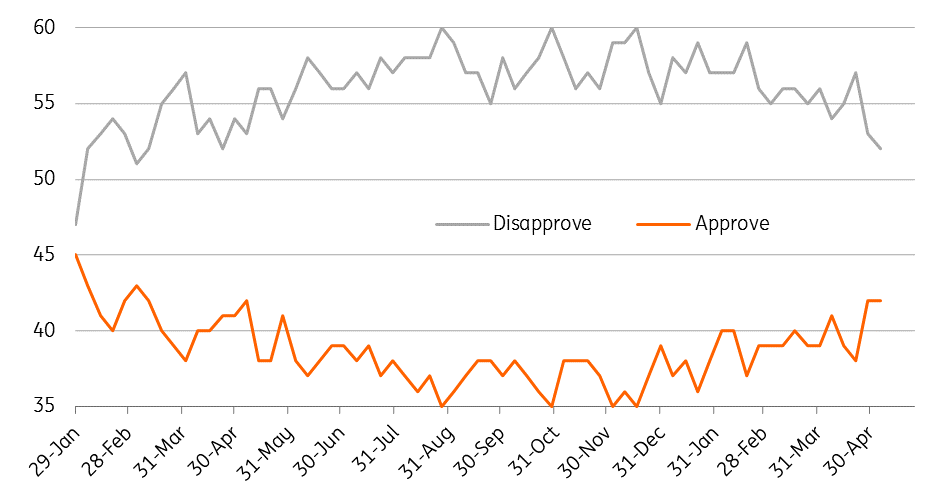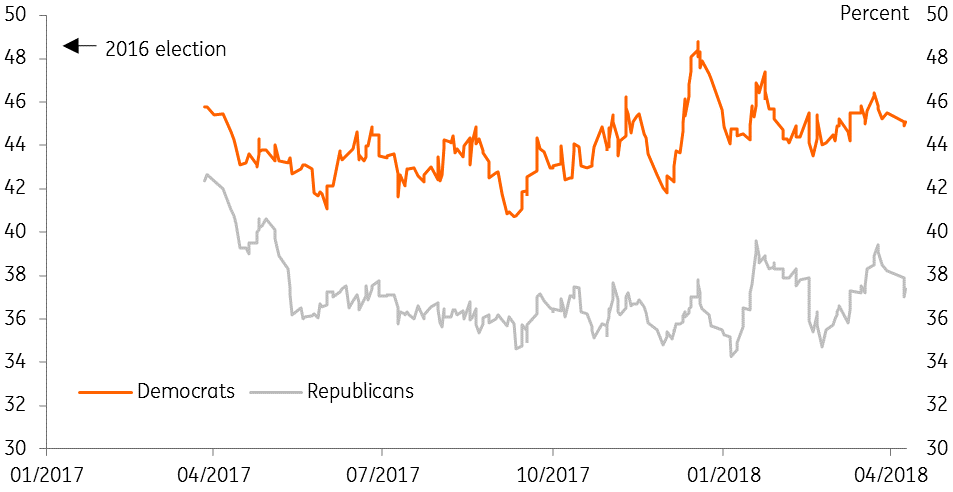US: Stormy relations
Growth looks set to pick up again in 2Q18, but geopolitical tensions remain and the Republicans look vulnerable ahead of the mid-term elections
As with most major economies, the first quarter of 2018 didn’t pan out quite as well as hoped. Bad weather, an aggressive protectionist lurch and financial market volatility all played a part, but it looks as though a stronger story is emerging for 2Q18. Nonetheless, geopolitical and trade tensions persist, as underlined by President Trump pulling out of the Iran nuclear deal. These steps seem to be bolstering Trump’s approval ratings despite ongoing media scrutiny of his personal life. The Republican Party is not benefiting though. Polls suggest they will lose control of Congress, which would severely curtail Trump’s legislative ambitions in the second half of his Presidential term.
Regaining momentum
Output growth of 2.3% annualised in 1Q was respectable but softer than the three quarters that preceded it. Most of the damage was done in January and February. High-frequency data suggests that momentum has since picked up, with consumer confidence, the jobs market and spending looking better in April. Tax cuts and rising incomes will continue to support domestic demand while net exports are also looking better, thanks in no small part to the lagged effects of dollar weakness.
Inflation is rising
Meanwhile, inflation pressures continue to build. The core personal consumer expenditure deflator is the only inflation reading that is below the Fed’s 2% target, and even that will soon be above. Price pressures were relatively muted in the April-August 2017 period so just a couple of 0.2% month-on-month readings will be enough to push annual inflation rates higher over the summer of 2018. We may see headline consumer price inflation up at 3% (or higher if oil prices continue to climb) and core at 2.5%. This would stoke fears of overheating in the US economy.
Average earnings growth is still relatively subdued, but the broader employment cost index is picking up more markedly while other surveys suggest pay is accelerating – the National Federation of Independent Business reported the net proportion of companies awarding pay rises has only been higher on one occasion in its 34-year history – May 2000.
Ongoing Fed rate hikes
Given this backdrop, we continue to look for three more Federal Reserve rate hikes this year with at least two more in 2019. We also see upward pressure on the longer end of the yield curve as markets increasingly take on board the risk of upside inflation surprises. As such, the yield curve should continue to flatten but remain upward sloping.
Furthermore, the fiscal deficit is set to hit 5% of GDP in the next year, and with the Fed running down its balance sheet, supply pressures could see yields rise. Then there is the threat that if trade tensions escalate, one possible response from China could be to become unpredictable at Treasury auctions. This could run the risk of the odd failed auction, creating more volatility and occasional yield spikes, which would hurt investor sentiment.
Trade tensions remain a key concern
Regarding trade tensions, the US has demanded that China cuts its $340bn trade surplus with America by nearly two-thirds over the coming two years and not launch any counter-measures. It is hard to see China complying, but we are hopeful we might see a similar pattern to the NAFTA negotiations. i.e. The US going in making very aggressive early demands before softening its stance over subsequent months. In fact, a new NAFTA agreement may not be far away. In any case, such aggressive cuts to the Chinese surplus will be difficult to achieve given the massive tax cuts that US consumers are likely to put to use buying foreign-made consumer goods. China will effectively have to block exports, which seems improbable.
Trump has seen his support rise but...
Recent opinion polls suggest that Democrats currently hold a seven-point lead heading into the mid-terms. March’s loss of Pennsylvania’s 18th District is a clear warning for the Republicans, who won it by nearly 20 points in 2016. Given the state’s long association with coal and steel, this suggests that while some people may respond positively to aggressive trade rhetoric, it is not going to be enough to win over a sceptical electorate.
President Trump approval rating

The whole of the House of Representatives is up for grabs in November, along with a third of the Senate, 36 governorships and numerous local seats and official positions. If the Democrats do well and take one or both chambers (the House is the most likely given the Democrats are defending the majority of the Senate seats up for election), this will allow them to block both Trump’s legislative agenda and any nominations to the judiciary or other posts. It would also give the Democrats much greater power to launch investigations into Trump and his administration, which would no doubt ratchet up talk of potential impeachment. The process for impeachment starts in the House, but it would still require two-thirds support from the Senate to pass, which doesn’t look very likely at this stage.
Mid-term election opinion polling

Big Republican losses would require much greater bipartisanship to get legislation passed, which would hurt the chances of any further tax changes and could potentially limit President Trump’s infrastructure spending ambitions. It would also mean no repeal of Obamacare.
Conversely, if the Republicans manage to spring a surprise and maintain control of all three legislative arms, it will likely embolden conservatives to push on ripping up President Obama’s legacy legislation with Trump taking the vote as an endorsement of his geopolitical and trade stance. Such an outcome is likely to trigger concern intensifying tensions with China.
This publication has been prepared by ING solely for information purposes irrespective of a particular user's means, financial situation or investment objectives. The information does not constitute investment recommendation, and nor is it investment, legal or tax advice or an offer or solicitation to purchase or sell any financial instrument. Read more
Download
Download article
11 May 2018
ING’s May Economic Update This bundle contains 8 Articles